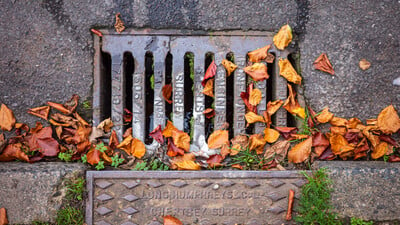Road gullies are a vital part of the UK’s drainage system, helping keep roads safe by efficiently managing water runoff. From busy motorways to residential streets, they prevent excess water from collecting on road surfaces, reducing hazards like flooding and hydroplaning.
To allow water to flow freely while preventing vehicles and people from falling into the gullies, they are usually fitted with a form of grating on top of the gully.
But not all road gully gratings are the same – different materials, designs and functions suit specific environments and demands. Let’s investigate the types of road gully gratings available and understand how they work to keep our roads clear and safe.
What Are Road Gully Gratings?
Road gully gratings are metal covers or grids placed over gully holes, usually found along the edge of roadways. They allow water to drain off the road and into the underlying sewer or drainage system while preventing debris, litter and leaves from entering the drainage system. This helps reduce blockages, ensures proper drainage flow and contributes to safer road conditions.
Types of Road Gully Gratings
Various types of road gully gratings are used across the UK, each designed to withstand specific conditions and meet unique requirements. Here’s a closer look at the main types.
1. Cast Iron Road Gully Gratings
Cast iron is a traditional choice for gully gratings, known for its durability and longevity. Cast iron gratings are commonly used in high-traffic areas such as motorways and urban roads, as they can withstand heavy loads and prolonged wear and tear.
Key Features of Cast Iron Gratings:
- Strength and durability: Ideal for areas with heavy vehicular traffic.
- High resistance to deformation and corrosion: Ensures a longer lifespan, even under challenging weather conditions.
- Heavyweight design: Reduces the risk of theft, as cast iron is challenging to remove without specialist equipment.
2. Ductile Iron Road Gully Gratings
Ductile iron is an advanced form of cast iron, enhanced for flexibility and strength. This makes ductile iron gratings particularly suitable for high-traffic and high-stress areas, as they can better handle impacts and sudden load shifts without cracking.
Benefits of Ductile Iron Gratings:
- Enhanced flexibility and strength: Makes them ideal for motorways and other high-traffic zones.
- Lighter weight compared to cast iron: Easier for contractors to install, without compromising on strength.
- Rust resistance: Provides excellent durability, even in wet or humid conditions.
3. Composite Road Gully Gratings
Composite materials such as fibreglass or reinforced polymers are gaining popularity as lighter alternatives to metal that are also less of a target for thieves. Composite gratings are generally used in areas with lighter traffic such as footpaths, pedestrian zones and residential streets.
Advantages of Composite Gratings:
- Lightweight: Easier to handle and install, especially in lower-traffic areas.
- Corrosion resistance: Composite materials that contain no metal will never rust, making them popular in coastal areas where conventional metal gratings might degrade faster.
- Theft resistance: Non-metal composition discourages theft, which can be an issue in some areas, as the material has no recycling value.
4. Steel Road Gully Gratings
Steel gratings, especially galvanised steel, are another option. These are commonly used for their versatility and durability, especially in environments where weight and easy maintenance are priorities.
Benefits of Steel Gratings:
- Strength and versatility: Steel gratings are durable and can be used in moderate traffic areas.
- Corrosion-resistant with galvanisation: This process prevents rusting, ensuring longevity.
- Lighter weight than cast iron or ductile iron: Facilitates easier installation and maintenance.
Design Differences and Functional Benefits
The design of a road gully grating significantly influences its function. For example:
Open Mesh Gratings
Open mesh gratings have wider gaps between the bars, allowing for rapid water drainage. However, they are less effective at preventing smaller debris from entering the drainage system. These gratings are often installed in areas with high water flow but limited debris.
Anti-Skid Surface Gratings
In regions with frequent rainfall or areas prone to ice, anti-skid surface gratings are preferred. These designs enhance traction, ensuring that vehicles and pedestrians don’t slip on wet or icy surfaces.
Lockable Gratings
In areas or locations prone to vandalism or theft, lockable gratings provide an extra level of security. These gratings are designed to be more tamper-resistant, reducing the risk of removal or damage.
Choosing the Right Road Gully Grating
When choosing a road gully grating, it’s essential to consider several factors:
- Traffic load: Heavy traffic areas need robust materials like cast or ductile iron.
- Environmental conditions: Coastal or humid areas benefit from corrosion-resistant materials.
- Safety needs: Anti-skid or lockable features enhance safety and security where needed.
Road gully gratings are essential for safe and effective road drainage. By selecting the right type of gully grating for each application, contractors and engineers can significantly improve road safety, drainage efficiency and longevity.
We hope you have found this information interesting and helpful. If you have any further questions you are always welcome to call our friendly team of experts on 01420 555600 or email [email protected].
Also, look out for more articles in our ongoing series of blog posts, bringing you useful information, insights, guides and tips on all things drainage!

Written by
Bob Stone
Technical Sales
Heading up our Technical Estimating Department, Bob is our in-house quantity surveyor.

